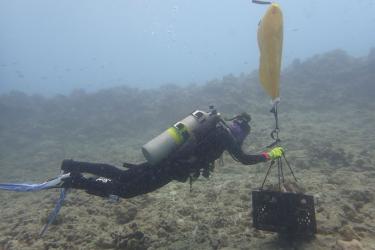With their beard-like protrusions, typically reddish body, and small white patch above the base of their tail, kūmū (Hawaiian whitesaddle goatfish) are easy to spot in the wild. That is, if you can find them.
Once abundant among Hawaiʻi reefs, the kūmū population has been on a steady decline in the main Hawaiian Islands for decades. “The general consensus is that the population has been overfished and is currently experiencing overfishing,” said Spencer Davis, a researcher at Hawaiʻi Pacific University’s Oceanic Institute. But Davis and his team are hoping to help the struggling, culturally important species with restorative aquaculture.
In a NOAA Fisheries-supported project, Davis is trying to establish the techniques to raise kūmū in the Institute’s finfish hatchery. If successful, he will work with local fishermen to tag and release hatchery-raised juveniles onto the reefs around the main Hawaiian Islands.
Fishermen who catch these tagged kūmū will receive financial compensation for reporting their catch. The information they will provide include when and generally where they caught the fish, as well as the length and weight of the fish.
This data will help Davis understand:
- How much the fish have grown since release
- How far they traveled from the release point
- How likely fishermen are to catch them
“We're trying to see if restorative aquaculture can be applied to this species and how effective it could be,“ Davis explained. “It would take a larger-scale effort to actually make a large-scale difference in the wild population. But this is a good start to give some general ideas of the potential for restorative aquaculture.”
Challenges Abound
The kūmū aquaculture project is supported by two NOAA Fisheries Saltonstall-Kennedy Grants.
In the first 2-year grant, awarded in 2021, Oceanic Institute focused on obtaining kūmū broodstock (spawning-size fish) and developing the necessary aquaculture techniques. “There are a lot of hurdles in culturing these reef species, especially one that's not commonly available just out in the water,” Davis said.
With help from the nonprofit Pacific Islands Fisheries Group, Davis solicited Hawaiʻi fishermen for live kūmū broodstock. But finding fishermen who knew where to get the fish and how to transport them to shore alive proved more difficult than expected. Davis initially wanted 40 broodstock before moving on to the next phase of the project, but he settled with just a few.
This next phase—getting the broodstock to spawn—was another time-consuming challenge. “It took quite a while to condition them, pamper them, and basically get them to be happy enough to spawn,” Davis said.
Kūmū spawn around sunset during winter, releasing eggs and sperm into the water for external fertilization. In Oceanic Institute’s broodstock tank, a fine mesh collected the eggs overnight. The next morning, researchers determined which eggs were viable simply by putting them all into a jar of static seawater. When left to rest, viable eggs floated and unviable eggs sank. By that afternoon, the good eggs hatched into larvae that were little more than a millimeter long.
Trial and Error
Once hatched, kūmū larvae will spend the next 3 days surviving on their yolk sac, until they develop eyes and a mouth to start eating.
“That’s the next hurdle,” Davis said. “What do you feed them?”
Kūmū larvae are picky eaters and require specific food that changes as they progress through their larval stages. But there is no guidebook to raising goatfish in a hatchery, so the team underwent a lot of trial and error. Davis had to not only determine the right food for the larvae but also the right conditions to get them to eat. This included considering factors such as:
- Amount of ambient light present
- Temperature and flow of the water
- Density of microalgae in the tank
- Types and abundance of live zooplankton such as copepods, rotifers, or Artemia brine shrimp
By the end of the first grant period, Davis was able to grow larvae into 2-week-old juveniles. But before he could continue figuring out the next steps in raising the fish, summer arrived and the broodstock stopped spawning.
Moving Forward
For the second 2-year grant, awarded in 2023, Davis will refine the aquaculture techniques to develop healthy kūmū juveniles before moving on to the tag-and-release phase. “What we want to do in this next round of trying to raise the larvae is really key in on how sensitive they are to temperature,” he said.
Since kūmū spawn in winter, the larvae require colder water than the other fish that Oceanic Institute raises in its hatchery. Davis is building a separate system to accommodate a broader range of temperatures for kūmū. Fully understanding their temperature requirements will better inform the Institute’s kūmū-rearing techniques. It’ll also help them gauge how the species may be affected by warming ocean temperatures in the coming years.
Kūmū are only found in the Hawaiian Islands. In traditional Native Hawaiian culture, they often served as offerings to the gods when a red fish was required. They were also sometimes offered in other situations, including when a canoe was launched, during hula ceremonies, and to atone for wrongdoings. In addition to this cultural significance, kūmū is a popular species for both commercial and recreational fishermen.
If the work is successful, it could open the door for large-scale production of kūmū for fisheries restoration, cultural use, and commercial markets. What’s more, aquaculture operations around the world could potentially use the techniques that Oceanic Institute is developing to raise other goatfish species.
These kūmū aquaculture projects were funded through the 2021 and 2023 Saltonstall-Kennedy National Program, a yearly grant competition that funds projects leading to the promotion, development, and marketing of U.S. fisheries.





